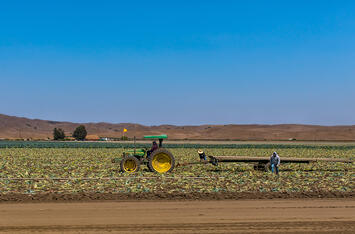
The world may see California largely as home to Silicon Valley and Hollywood, but it’s agriculture technology where we can most clearly outshine our competitors. In a new study, “Nurturing California Industries,” we identified it as among the six industries most critical to the state’s economic future.
In many ways, advances in agricultural technology will have as much to do for California’s future as AI, streaming movies and electric vehicles. Agriculture is, by far, California’s strongest sector in terms of employment. In the latest 2022 Census of Wages and Employment, agriculture employs 419,582 people in this state, more than four times the number in the next-largest state, Washington.
While tech businesses and corporate headquarters head elsewhere, California’s agricultural supremacy remains unchallenged. The agricultural industry provides more than a third of the country’s vegetables and three-quarters of the country’s fruits and nuts. In 2021, the state’s farms and ranches earned $51.1 billion in revenues for their products. That year agricultural exports totaled $22.5 billion in 2021, an increase of 7% from 2020.
California agriculture nevertheless faces significant challenges from the changing climate and state policies responding to that change. Some environmental groups, in places as diverse as Massachusetts’ Berkshires and the Mojave Desert, are concerned about the expansion of wind and solar facilities in rural areas and open space. In California, the Nature Conservancy estimates that to fulfill the state’s “net zero” targets would require 1.6 million to 3.1 million acres — up to 10% of current farming acreage — converted to clean energy use in coming decades.
Regulatory changes will likely alter California’s agriculture industry. The respite from the drought in the last year won’t change the dynamic. The cost of regulatory compliance has grown steadily in the last decade. State methane regulations already have led to an exodus of dairies, once one of the largest food producing sectors in California. Cropland has declined steadily, falling by half a million acres in the last two years, with at least another 500,000 more expected to be lost by 2040 due to persistent water shortages.
Addressing the needs in the country’s richest agricultural economy lies in building stronger cooperation between state government and farmers, and a focus on researching and implementing new technologies.
Producing food for a population of hundreds of millions, as California does, requires a focus on efficiency and methods that are as advanced as any semiconductor or automobile manufacturing operation.
It is important to understand that ag tech is not one single technology but rather a panoply of them that are redefining both the nature of how we grow our food and the nature of what we even consider to be food. California is already a leader in several of these areas.
Automation of planting, fertilizing and harvesting of crops and animal food products.
Technology advancements in these areas — robotic harvesters, moisture sensors monitored by drones and robotic delivery of hormones essential to cows’ milk production — reduce the number of people needed to produce food and to improve yields.
Read the rest of this piece at Los Angeles Times.
Joel Kotkin is the author of The Coming of Neo-Feudalism: A Warning to the Global Middle Class. He is the Roger Hobbs Presidential Fellow in Urban Futures at Chapman University and Executive Director for Urban Reform Institute. Learn more at joelkotkin.com and follow him on Twitter @joelkotkin.
Marshall Toplansky is a widely published and award-winning marketing professional and successful entrepreneur. He co-founded KPMG's data & analytics center of excellence and now teaches and consults corporations on their analytics strategies.
Photo: RisingThermals via Flickr under CC 2.0 License.












